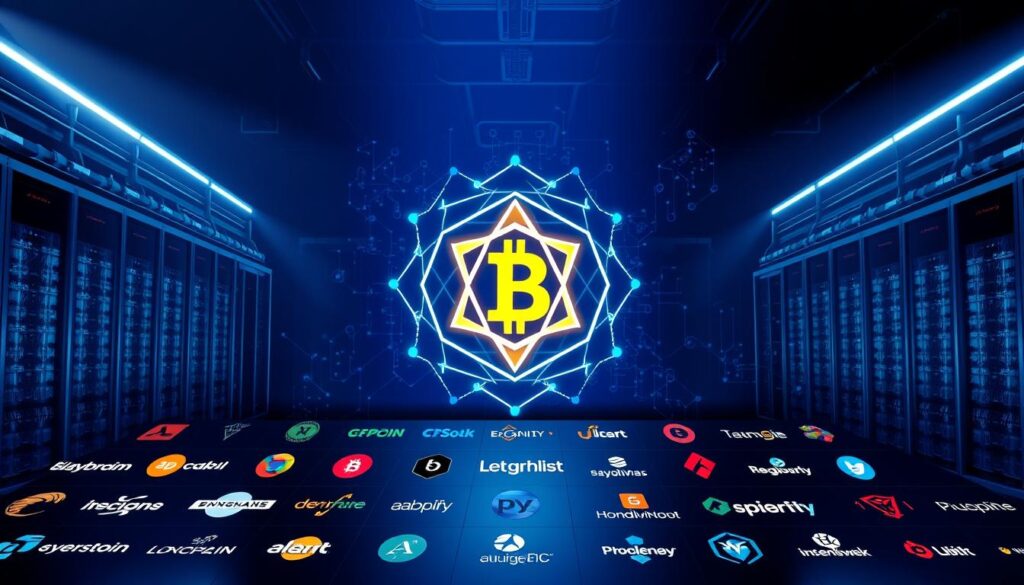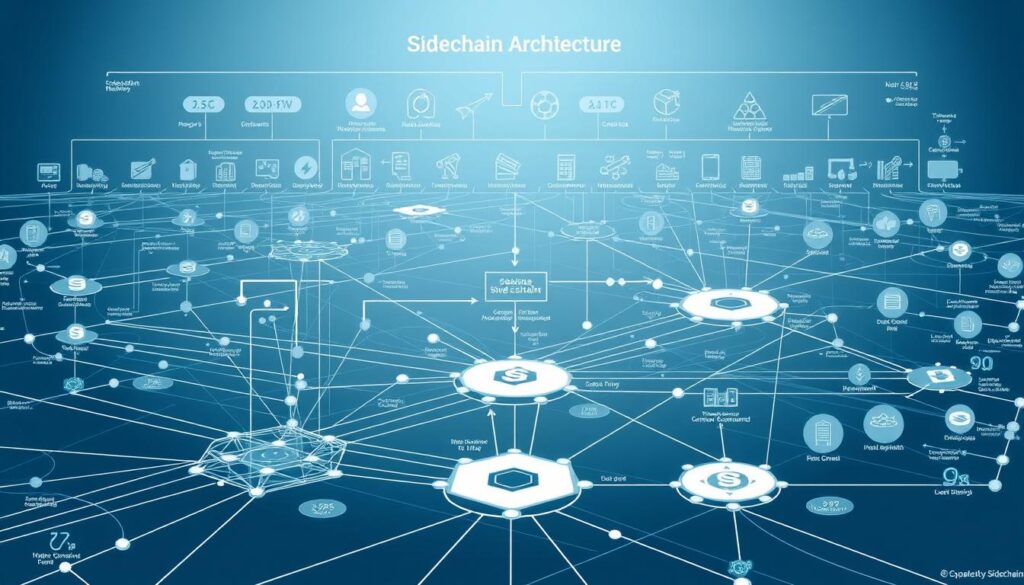Now Reading: Blockchain Scalability Solutions: Overcoming Network Limitations
- 01
Blockchain Scalability Solutions: Overcoming Network Limitations
Blockchain Scalability Solutions: Overcoming Network Limitations

Digital payment systems like Visa handle over 1,700 transactions every second. In contrast, major distributed ledgers process fewer than 10 transactions in the same timeframe. This gap highlights a critical challenge for modern networks: balancing speed with security and decentralization.

As more users join these systems, slow processing times and rising fees become unavoidable. These limitations make everyday use impractical, even as interest in decentralized technology grows. Developers face a complex puzzle—boosting performance without sacrificing core principles like trustlessness.
Current approaches focus on two main strategies. Some teams are redesigning base protocols to handle more activity natively. Others build secondary frameworks that operate atop existing networks, reducing strain on the main system. Both methods aim to achieve faster validation and lower costs for users.
Key Takeaways
- Traditional payment systems outperform leading decentralized networks by 200x in transaction speed
- Increased usage often leads to higher fees and slower confirmations on current systems
- Security and decentralization risks emerge when prioritizing speed improvements
- Protocol upgrades and secondary layers show promise for enhancing performance
- Maintaining core values remains essential during technical advancements
Understanding Blockchain Scalability Challenges
Global payment processors complete more transactions in a minute than some networks handle in hours. This gap becomes glaring when comparing systems like Bitcoin’s 7 transactions per second to Visa’s 24,000. Limited throughput creates bottlenecks, forcing users to choose between waiting hours or paying premium fees.
Transaction Speed and Throughput Limitations
Decentralized systems struggle with basic math: more users mean slower confirmations. When demand spikes, transaction queues grow exponentially. Ethereum’s average processing time doubled during 2021’s NFT boom, leaving gamers and traders stranded mid-purchase.
Network Congestion and Rising Fees
Fee structures turn chaotic during peak usage. Bitcoin’s 2017 bull run saw costs hit $60 per transfer—enough to buy dinner for two. Even routine Ethereum swaps now cost $5-$30, pricing out small-scale users. These spikes occur because limited block space forces bidding wars among participants.
Micropayments become impractical when fees exceed transaction values. A $2 coffee purchase with $3 network costs? Most would abandon the idea. This reality stalls adoption in retail and logistics sectors where high-volume, low-value transfers dominate.
For deeper insights into these limitations, explore our analysis of network behavior under stress. The data reveals how fee markets evolve during congestion events and what it means for everyday users.
The Blockchain Trilemma: Balancing Scalability, Security, and Decentralization
Network architects face a persistent challenge when optimizing digital ledgers. The blockchain trilemma reveals why systems struggle to maintain speed, safety, and broad participation simultaneously. Strengthening one element often weakens others—like tightening a guitar string until neighboring strings go slack.

Decentralization Concerns in Scaling
High-speed networks often shrink their validator groups. EOS processes 4,000 transactions per second using just 21 nodes—fewer than most corporate boardrooms. While efficient, this concentration raises questions about control distribution. Could a small group manipulate transactions or alter rules?
Wider participation slows decision-making but enhances trust. Bitcoin’s 14,000+ nodes validate transactions democratically, creating resilience through diversity. Scaling methods requiring fewer participants risk creating centralized bottlenecks that contradict core distributed principles.
Security Implications and Trade-offs
Faster validation sometimes introduces attack opportunities. Networks using streamlined consensus methods might:
- Reduce verification steps for speed
- Limit node diversity to prevent delays
- Accept smaller security margins during peak loads
Proof-of-stake systems address some issues by aligning incentives differently than energy-intensive proof-of-work models. However, each approach carries unique risks—from stake concentration to 51% attacks. Developers constantly weigh breach risks against performance needs, knowing every choice reshapes the system’s fundamental nature.
An Introduction to Layer 1 Scaling Solutions
Digital networks evolve through foundational upgrades that reshape their core capabilities. Layer 1 improvements modify a system’s base protocol to handle more activity directly, like widening highways to reduce traffic jams. These changes often spark heated debates among developers but deliver measurable performance gains.

Enhancing Consensus Mechanisms
Validation methods determine how quickly networks confirm transactions. Ethereum’s shift from proof-of-work to proof-of-stake slashed energy use by 99% while boosting speed. This consensus upgrade:
- Reduced average transaction time from 6 minutes to 12 seconds
- Increased throughput from 10 to 32 transactions per second
- Enabled parallel processing through validator committees
Sharding and Bigger Blocks
Bitcoin Cash demonstrated block size expansion’s impact by increasing capacity 32x. This simple layer solution lets each block store 5,000 transactions instead of 300. Meanwhile, sharding divides networks into specialized groups:
- 1000 nodes split into 10 shards process transactions simultaneously
- Each shard handles specific data types or geographic regions
- Cross-shard communication protocols prevent duplication
These approaches require careful coordination. Bigger blocks demand more storage from nodes, potentially centralizing the network. Sharding introduces complexity but offers linear scaling—doubling shards could double capacity. Both methods prove that protocol changes can unlock new potential without compromising security.
Exploring Layer 2 Scaling Solutions
Imagine paying for groceries while your digital wallet handles 500 payments in the time it takes to bag an apple. Layer 2 systems make this possible by moving heavy lifting away from congested networks. These frameworks act like express lanes, processing transactions externally before updating the main system.

Off-Chain Processing for Speed
State channels let users exchange value privately before finalizing results. Think of them as digital tabs at a bar—you order multiple drinks, then settle the total later. This approach:
- Reduces main network load by 90% in stress tests
- Cuts fees to pennies for microtransactions
- Enables instant payments between frequent partners
Sidechains and Rollups Overview
Independent networks called sidechains operate like specialized workshops. They follow custom rules but connect to primary systems through two-way bridges. Polygon, for example, processes Ethereum-compatible transfers 100x faster using this model.
Rollups take a different approach by compressing data. They bundle 1,000 transfers into single packages—like shipping containers moving goods efficiently. This method slashes costs while maintaining cryptographic proof of validity, crucial for systems requiring audit trails.
These layer solutions demonstrate how interconnected networks can evolve without overhauling their foundations. By shifting workloads strategically, they preserve core security while delivering the speed modern users demand.
Deep Dive into State Channels
State channels create private pathways for rapid value exchange, moving most activity away from crowded networks. Participants open temporary corridors to conduct numerous transfers instantly, only interacting with the main system when starting or closing sessions. This approach resembles colleagues passing notes during a meeting instead of announcing every word to the entire room.
How State Channels Operate
Users begin by locking funds in a shared wallet requiring multiple approvals. Once active, they exchange value freely through signed messages—like signing a tab at a coffee shop. The Lightning Network demonstrates this with Bitcoin:
- Opens payment routes between participants
- Processes millions of microtransactions off-chain
- Settles net balances periodically on the main network
Advantages and Limitations
These systems excel in speed-sensitive scenarios but face operational constraints. Key benefits include:
- Subsecond transaction finality
- Fees below $0.01 per transfer
- Enhanced privacy through off-record exchanges
Challenges emerge in setup complexity and channel management. Participants must:
- Maintain constant connectivity
- Pre-fund liquidity pools
- Monitor for potential disputes
While state channels reduce decentralization by requiring trusted relationships between parties, they unlock new possibilities for high-frequency interactions. Gaming platforms and payment processors increasingly adopt this model for repetitive transactions between known entities. For a detailed exploration of these systems, review our guide on Layer 2 state channels.
Rollups: Enhancing Throughput and Reducing Fees
Modern users demand speed without compromising security. Rollups answer this need by processing hundreds of transfers off-chain before compressing them into single batches. This method slashes costs while preserving network integrity through cryptographic verification.
Optimistic vs Zero-Knowledge Approaches
Optimistic rollups operate on trust-but-verify principles. They assume transactions are valid unless challenged during a 7-day window. This system:
- Supports existing Ethereum smart contracts
- Charges 90% less than mainnet transfers
- Requires delayed withdrawals for dispute resolution
ZK-Rollups take a different path. Complex mathematical proofs validate every batch instantly, eliminating waiting periods. Platforms like zkSync finalize payments in minutes while maintaining military-grade security. Their advanced cryptography enables:
- Immediate fund availability
- Enhanced privacy through proof systems
- 50x faster confirmations than optimistic models
Both methods reduce strain on base layers but involve trade-offs. Optimism’s compatibility makes it ideal for decentralized apps needing minimal changes. ZK-Rollups suit services requiring speed and privacy-enhancing blockchain technology, though their complex setup demands specialized developers.
Implementing Cross-Chain Solutions
Cross-chain communication reshapes how value moves across digital networks. These protocols act as translators, letting separate systems exchange assets and information. Without them, each network operates in isolation, limiting collective potential.
Blockchain Bridges and Data Sharing
Bridges lock assets on one chain while creating mirrored tokens elsewhere. Wormhole enables transfers between Ethereum, Solana, and Avalanche through secure data relays. Multichain simplifies swaps across 35+ networks, demonstrating interconnected ecosystems in action.
These systems face critical security tests. The 2022 Wormhole breach ($320M loss) exposed vulnerabilities in bridge designs. Developers now prioritize decentralized validation and multi-signature approvals to reduce attack surfaces.
Overcoming Interoperability Challenges
Diverse technical standards create friction between networks. Some chains use different programming languages, while others employ incompatible security models. Standardized communication protocols emerge as essential tools for seamless data flows.
Innovations like atomic swaps and cross-chain smart contracts address these hurdles. These methods allow direct peer-to-peer exchanges without third-party intermediaries. As networks adopt shared frameworks, users gain frictionless access to decentralized services across ecosystems.
FAQ
Why do decentralized networks struggle with slow transaction speeds?
Networks like Ethereum and Bitcoin rely on consensus protocols that require multiple validations. This process ensures security but limits how many transactions each block can handle, creating bottlenecks during peak usage.
How do rising fees impact everyday users?
When demand exceeds a network’s capacity, fees spike as users compete to prioritize their transactions. This makes microtransactions impractical and reduces accessibility for smaller participants.
Can scaling methods compromise decentralization?
Some approaches, like increasing block sizes, may centralize control by requiring more powerful hardware for validators. Solutions must balance efficiency with maintaining a distributed node network.
What makes sharding effective for improving throughput?
Sharding splits a network into smaller segments (shards) that process transactions in parallel. This reduces the load on individual nodes, enabling systems like Ethereum 2.0 to handle thousands of transactions per second.
How do rollups reduce costs without sacrificing security?
Rollups bundle multiple off-chain transactions into a single on-chain proof. Optimistic rollups assume validity unless challenged, while ZK-rollups use cryptographic proofs, both lowering fees by minimizing on-chain data.
Are state channels suitable for long-term interactions?
State channels excel for repeated transactions between parties, like gaming or micropayments. However, they require participants to stay online and lock funds, making them less ideal for one-time exchanges.
What role do bridges play in cross-chain interoperability?
Bridges like Polygon’s PoS chain enable asset transfers between separate networks. They facilitate data sharing but introduce risks if security models differ, requiring robust validation mechanisms.
Can layer 2 solutions work independently of base layer upgrades?
Yes. Protocols like Lightning Network (Bitcoin) and Arbitrum (Ethereum) operate atop existing chains, offering faster settlements without altering the underlying protocol. However, they depend on the base layer for finality.















